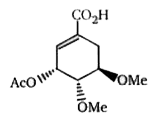The reaction 2NO+Br2→2NOBr, obeys the following mechanism:
NO+Br2fast⇐⇒NOBr2,NOBr2+NOSlow−−→2NOBr The rate expression of the above reaction can be written as
r=k[NO]2[Br2]2
r=k[NO][Br2]
r=k[NO][Br2]
r=k[NOBr2]
The correct Answer is:A
To derive the rate expression for the reaction 2NO+Br2→2NOBr based on the provided mechanism, we can follow these steps:
Step 1: Identify the Rate-Determining Step
The mechanism provided states:
1. NO+Br2fast⇌NOBr2
2. NOBr2+NOslow→2NOBr
The slow step is the rate-determining step (RDS), which means the rate of the overall reaction is determined by this step.
Step 2: Write the Rate Expression for the Slow Step
For the slow step, the rate expression can be written as:
Rate=k⋅(NOBr2)⋅(NO)
where k is the rate constant for the slow step.
Step 3: Express the Intermediate in Terms of Reactants
Since NOBr2 is an intermediate, we need to express its concentration in terms of the reactants. From the fast equilibrium step, we can write:
Keq=(NOBr2)(NO)(Br2)
Thus, we can rearrange this to find:
(NOBr2)=Keq⋅(NO)⋅(Br2)
where Keq is the equilibrium constant for the first step.
Step 4: Substitute the Expression for NOBr2 into the Rate Equation
Now, we substitute the expression for NOBr2 back into the rate expression:
Rate=k⋅(Keq⋅(NO)⋅(Br2))⋅(NO)
This simplifies to:
Rate=k⋅Keq⋅(NO)2⋅(Br2)
Step 5: Final Rate Expression
We can denote k′=k⋅Keq as a new rate constant for the overall reaction. Thus, the final rate expression is:
Rate=k′⋅(NO)2⋅(Br2)
Conclusion
The rate expression for the reaction 2NO+Br2→2NOBr is:
Rate=k′⋅(NO)2⋅(Br2)
The mechanism provided states:
1. NO+Br2fast⇌NOBr2
2. NOBr2+NOslow→2NOBr
For the slow step, the rate expression can be written as:
Rate=k⋅(NOBr2)⋅(NO)
where k is the rate constant for the slow step.
Since NOBr2 is an intermediate, we need to express its concentration in terms of the reactants. From the fast equilibrium step, we can write:
Keq=(NOBr2)(NO)(Br2)
Thus, we can rearrange this to find:
(NOBr2)=Keq⋅(NO)⋅(Br2)
where Keq is the equilibrium constant for the first step.
Now, we substitute the expression for NOBr2 back into the rate expression:
Rate=k⋅(Keq⋅(NO)⋅(Br2))⋅(NO)
This simplifies to:
Rate=k⋅Keq⋅(NO)2⋅(Br2)
We can denote k′=k⋅Keq as a new rate constant for the overall reaction. Thus, the final rate expression is:
Rate=k′⋅(NO)2⋅(Br2)
The rate expression for the reaction 2NO+Br2→2NOBr is:
Rate=k′⋅(NO)2⋅(Br2)
Topper's Solved these Questions
- CHEMICAL KINETICSBook:NCERT FINGERTPS ENGLISHChapter:CHEMICAL KINETICSExercise:NCERT EXEMPLAR PROBLEMS
Explore 17 Videos
- CHEMICAL KINETICSBook:NCERT FINGERTPS ENGLISHChapter:CHEMICAL KINETICSExercise:ASSERTION & REASON
Explore 15 Videos
- CHEMICAL KINETICSBook:NCERT FINGERTPS ENGLISHChapter:CHEMICAL KINETICSExercise:Assertion And Reason
Explore 15 Videos
- BIOMOLECULESBook:NCERT FINGERTPS ENGLISHChapter:BIOMOLECULESExercise:Assertion And Reason
Explore 15 Videos
- CHEMISTRY IN EVERYDAY LIFE Book:NCERT FINGERTPS ENGLISHChapter:CHEMISTRY IN EVERYDAY LIFE Exercise:NCERT Exemplar
Explore 15 Videos
Similar Questions
For the reaction 2NO2+F2→2NO2F, following mechanism has been provided:
NO2+F2slow−−→NO2F+F
NO2+Ffast−−→NO2F
Thus rate expression of the above reaction can be writtens as:
View SolutionThe mechanism of the reaction
2NO+O2→2NO2 is
NO+NOk1⇐⇒k−1N2O2(fast)
N2O2+O2k2−−→2NO2(slow)
The rate constant of the reaction is
View Solution
Knowledge Check
 (de-colourises Br2 water)
(de-colourises Br2 water)
Product (A) of the above reaction is :A B
B C
C D
D
CH3−CH2−CH2−CH3Br2/hv−−−−→
Major product in the above reaction is :ARacemic mixtureBMesoCDiastereomersDConstitutional isomersFor a reaction, 2NO+2H2→N2+2H2O, the possible mechanism is
NO⇔N2O2
N2O2+H2Slow−−→N2O+H2O
N2O+H2Ofast−−→N2+H2O
What is the rate law and order of the reaction?ARate = [N2O2], order = 1BRate = [N2O2][H2], order = 2CRate = [N2O2]2 order = 2DRate = [N2O2]2[H2], order = 3
CH3CH2CH2CONH2Br2/KOH−−−−−−→Product
The organic product of above reaction is.
View Solution
Br2/heat−−−−−→ P, P is
View SolutionThe rate constant for the decompoistion of a certain reaction is described by the equation:
logk(s−1)=14−1.25×104KT
A two-step mechanism has been suggested for the reaction of nitric oxide and bromine:
NO(g)+Br2(g)k1−−→NOBr2(g)
NOBr2(g)+NO(g)k2−−→2NOBr(g)
The observed rate law is, rate =k[NO]2[Br2]. Hence, the rate-determining step is
View SolutionThe final product (Y) of the following reaction is:
C2H4Br2−−→ X Ph3SnH−−−−→ Y
View SolutionSilver Acetate + Br2CS2−−→ Main Product . The major product of this reaction is
View Solution

